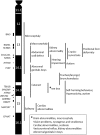The phenotypic spectrum of proximal 6q deletions based on a large cohort derived from social media and literature reports
- PMID: 29904178
- PMCID: PMC6138703
- DOI: 10.1038/s41431-018-0172-9
The phenotypic spectrum of proximal 6q deletions based on a large cohort derived from social media and literature reports
Abstract
Proximal 6q (6q11-q15) deletions are extremely rare and little is known about their phenotypic consequences. Since parents and caregivers now use social media to seek information on rare disorders, the Chromosome 6 Project has successfully collaborated with a Facebook group to collect data on individuals worldwide. Here we describe a cohort of 20 newly identified individuals and 25 literature cases with a proximal 6q deletion. Microarray results and phenotype data were reported directly by parents via a multilingual online questionnaire. This led to phenotype descriptions for five subregions of proximal 6q deletions; comparing the subgroups revealed that 6q11q14.1 deletions presented less severe clinical characteristics than 6q14.2q15 deletions. Gastroesophageal reflux, tracheo/laryngo/bronchomalacia, congenital heart defects, cerebral defects, seizures, and vision and respiratory problems were predominant in those with 6q14.2q15 deletions. Problems related to connective tissue (hypermobility, hernias and foot deformities) were predominantly seen in deletions including the COL12A1 gene (6q13). Congenital heart defects could be linked to deletions of MAP3K7 (6q15) or TBX18 (6q14.3). We further discuss the role of ten genes known or assumed to be related to developmental delay and/or autism (BAI3, RIMS1, KCNQ5, HTR1B, PHIP, SYNCRIP, HTR1E, ZNF292, AKIRIN2 and EPHA7). The most influential gene on the neurodevelopmental phenotype seems to be SYNCRIP (6q14.3), while deletions that include more than two of these genes led to more severe developmental delay. We demonstrate that approaching individuals via social media and collecting data directly from parents is a successful strategy, resulting in better information to counsel families.
Conflict of interest statement
The authors declare that they have no conflict of interest.
Figures




Similar articles
-
The phenotypic spectrum of terminal 6q deletions based on a large cohort derived from social media and literature: a prominent role for DLL1.Orphanet J Rare Dis. 2023 Mar 19;18(1):59. doi: 10.1186/s13023-023-02658-w. Orphanet J Rare Dis. 2023. PMID: 36935482 Free PMC article.
-
The phenotypic spectrum of terminal and subterminal 6p deletions based on a social media-derived cohort and literature review.Orphanet J Rare Dis. 2023 Mar 24;18(1):68. doi: 10.1186/s13023-023-02670-0. Orphanet J Rare Dis. 2023. PMID: 36964621 Free PMC article. Review.
-
Interstitial deletions of chromosome 6q: genotype-phenotype correlation utilizing array CGH.Clin Genet. 2007 Mar;71(3):260-6. doi: 10.1111/j.1399-0004.2007.00757.x. Clin Genet. 2007. PMID: 17309649
-
De novo microdeletions of chromosome 6q14.1-q14.3 and 6q12.1-q14.1 in two patients with intellectual disability - further delineation of the 6q14 microdeletion syndrome and review of the literature.Eur J Med Genet. 2012 Aug-Sep;55(8-9):490-7. doi: 10.1016/j.ejmg.2012.03.003. Epub 2012 Apr 12. Eur J Med Genet. 2012. PMID: 22561202 Review.
-
A distinctive phenotype associated with an interstitial deletion 6q14 contained within a de novo pericentric inversion 6 (p11.2q15).Cytogenet Cell Genet. 2000;91(1-4):192-8. doi: 10.1159/000056843. Cytogenet Cell Genet. 2000. PMID: 11173855 Review.
Cited by
-
C2H2-Type Zinc Finger Proteins in Brain Development, Neurodevelopmental, and Other Neuropsychiatric Disorders: Systematic Literature-Based Analysis.Front Neurol. 2020 Feb 14;11:32. doi: 10.3389/fneur.2020.00032. eCollection 2020. Front Neurol. 2020. PMID: 32117005 Free PMC article. Review.
-
Parent-reported phenotype data on chromosome 6 aberrations collected via an online questionnaire: data consistency and data availability.Orphanet J Rare Dis. 2023 Mar 19;18(1):60. doi: 10.1186/s13023-023-02657-x. Orphanet J Rare Dis. 2023. PMID: 36935495 Free PMC article.
-
Requirements for the neurodevelopmental disorder-associated gene ZNF292 in human cortical interneuron development and function.Cell Rep. 2025 May 27;44(5):115597. doi: 10.1016/j.celrep.2025.115597. Epub 2025 Apr 20. Cell Rep. 2025. PMID: 40257863 Free PMC article.
-
Akirin proteins in development and disease: critical roles and mechanisms of action.Cell Mol Life Sci. 2020 Nov;77(21):4237-4254. doi: 10.1007/s00018-020-03531-w. Epub 2020 May 2. Cell Mol Life Sci. 2020. PMID: 32361777 Free PMC article. Review.
-
TAB2 deletions and variants cause a highly recognisable syndrome with mitral valve disease, cardiomyopathy, short stature and hypermobility.Eur J Hum Genet. 2021 Nov;29(11):1669-1676. doi: 10.1038/s41431-021-00948-0. Epub 2021 Aug 30. Eur J Hum Genet. 2021. PMID: 34456334 Free PMC article.
References
Publication types
MeSH terms
LinkOut - more resources
Full Text Sources
Other Literature Sources
Medical
Miscellaneous

